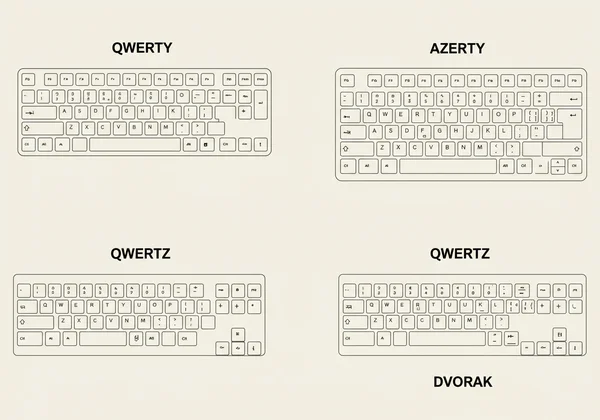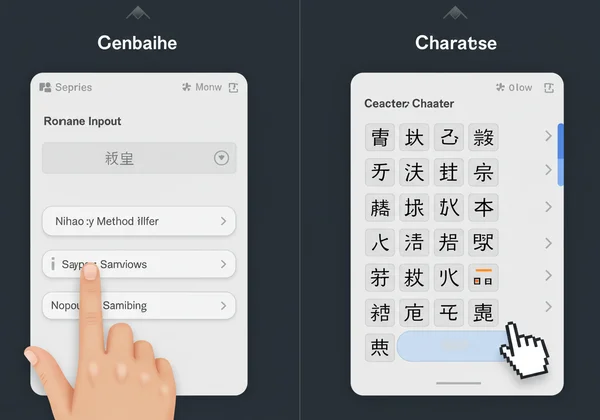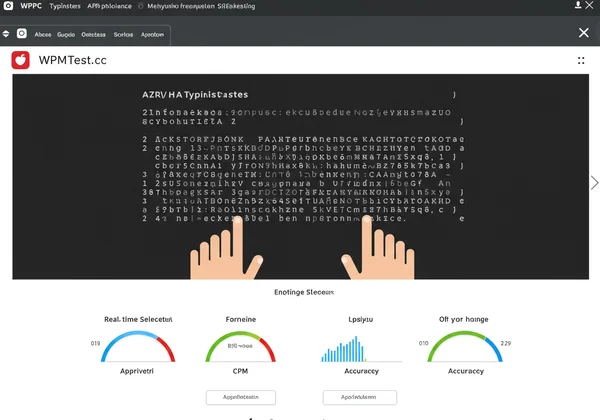Master Multilingual Typing: Improve WPM & Test Your Typing Speed Across Languages
The world is more connected than ever, and typing efficiently in multiple languages has become a vital skill for everyone from students on international projects to professionals collaborating globally, or simply language enthusiasts. But it's not just about knowing the words; it's about speed and precision. How can you take a WPM test online when switching between different alphabets and keyboard layouts?
This guide explores diverse keyboard configurations, advanced input methods for character-based languages, and actionable strategies for building speed and precision. Get ready to break the language barrier, one keystroke at a time. To see where you stand right now, take a typing test on our platform.

Understanding Diverse Keyboard Layouts
While many of us have only ever known the standard QWERTY layout, it's just one piece of a global puzzle. Different regions and languages have adapted keyboards to better suit their linguistic needs, creating a variety of layouts. Understanding these is the first step toward non-QWERTY keyboard proficiency.
Beyond QWERTY: Exploring AZERTY and QWERTZ
The most common alternatives to QWERTY in the Western world are AZERTY and QWERTZ. The AZERTY layout is standard in France and Belgium, swapping the 'Q' and 'A' keys as well as the 'W' and 'Z' keys. It also repositions the 'M' key and changes number keys to require the Shift key for digits, prioritizing access to accented characters like 'é' and 'à' which are common in French.
Similarly, the QWERTZ layout is used in Germany and Central Europe. Its primary change is swapping the 'Z' and 'Y' keys. This is because 'Z' is a much more common letter than 'Y' in German, and the 'T' and 'Z' combination appears frequently. These layouts are prime examples of how keyboards are optimized for specific languages, improving typing flow for native speakers.
The Efficiency Promise: Dvorak, Colemak, and Other Alternative Layouts
Beyond regional variations, some layouts were designed from the ground up to maximize typing speed and comfort. The most famous of these is the Dvorak layout, created in the 1930s. It places the most frequently used letters on the home row, minimizing finger movement and aiming to increase typing rhythm and reduce errors. Proponents claim it can lead to faster speeds with less strain.
Another popular alternative is Colemak, which is a more modern design. It makes fewer changes from QWERTY than Dvorak does, making it easier for existing typists to learn. Like Dvorak, it prioritizes the home row for common letters and aims for a more balanced workload between hands. While these layouts require a significant time investment to learn, they offer a path to peak typing efficiency for dedicated users.
How Layout Affects Your Multilingual Typing Speed (WPM)
Your choice of keyboard layout directly impacts your potential words per minute (WPM). Using a layout not optimized for your primary language can feel clunky and slow you down, as common letters may be in awkward positions. For example, a native French speaker will almost certainly achieve a higher WPM on an AZERTY keyboard than on a QWERTY one.
Ultimately, speed is a function of familiarity and muscle memory. The "best" layout is the one that allows your fingers to move fluidly and instinctively. Whether that’s QWERTY, a regional variant, or an ergonomic alternative depends entirely on the languages you use and your commitment to practice.

Mastering International Typing & Advanced Input Methods
For languages that don't use the Latin alphabet, simply changing the keyboard layout isn't enough. International typing for scripts like Chinese, Japanese, or Arabic requires sophisticated Input Method Editors (IMEs), which are software tools that translate your keystrokes into complex characters.
Inputting Character-Based Languages: Pinyin, Hiragana, and More
Typing in languages with thousands of characters, such as Mandarin Chinese, would be impossible with a one-key-per-character system. This is where IMEs come in. For Chinese, the most common method is Pinyin input. Users type the phonetic Romanization of a character (its Pinyin), and the IME presents a list of matching characters to choose from. Modern IMEs are incredibly intelligent, predicting the correct character based on context.
Similarly, Japanese uses a combination of Hiragana, Katakana, and Kanji characters. Typists usually input words phonetically using a Romanized script (Romaji), which the IME converts into the appropriate Hiragana or Katakana. For Kanji, the IME provides a selection based on the phonetic input, much like Pinyin. Mastering these IMEs is a skill in itself and is essential for achieving a high WPM in these languages.

Seamless Language Switching: Tips for Your Operating System
A common frustration for multilingual typists is the clunky process of switching between languages. Fortunately, both Windows and macOS have built-in shortcuts to make this seamless.
- On Windows: You can typically switch between installed keyboard layouts by pressing
Windows Key + Spacebar. - On macOS: The default shortcut is usually
Control + Spacebarto bring up a language selection menu.
Setting up your desired languages in your operating system's settings and memorizing these simple shortcuts can save you countless seconds and prevent disruptions to your workflow. This allows you to maintain your typing rhythm as you move between different languages in a single document or conversation.
Virtual Keyboards and On-Screen Input for Less Common Scripts
What if you need to type in a language with a unique script that isn't widely supported by physical keyboards? This is where virtual keyboards become invaluable. Both Windows and macOS include on-screen keyboards that can display any installed language layout. This allows you to click on characters with your mouse or see the layout for reference while you type. These are excellent tools for occasional use or for learning the layout of a new language before committing it to muscle memory.
Practical Strategies: Master Multilingual Typing Speed & Accuracy
Understanding the tools is only half the battle. True mastery comes from dedicated and intelligent practice. By focusing on fundamental skills and using the right resources, you can develop the fluency needed to type efficiently in any language you choose.
Building Muscle Memory for Each Language Layout
The core of fast typing is touch typing—the ability to type without looking at the keyboard. This relies on building strong muscle memory, where your fingers know the location of each key instinctively. When learning a new layout, you are essentially programming a new set of movements into your brain.
The key is consistency. Dedicate short, focused practice sessions each day rather than one long, exhausting session per week. Start slowly, focusing on accuracy above all else. Speed will naturally follow as your fingers learn their new positions. Don't switch back and forth between layouts in the early stages, as this will confuse your muscle memory.
The Power of Practice: Using Language-Specific Texts
Generic typing drills are good for fundamentals, but to truly master a language, you need to practice with authentic texts. Typing actual words, sentences, and paragraphs in your target language helps you internalize its unique rhythm, common letter combinations, and punctuation rules. This is far more effective than typing random strings of characters.
For professionals or students, this is a perfect opportunity to combine work with practice. Instead of generic text, try typing out an article, a report, or even an email related to your field. This targeted approach not only improves your WPM test score but also reinforces vocabulary. You can use a tool that allows for custom typing practice to make your sessions more relevant.
Leveraging the WPM test tool for Multilingual Speed & Accuracy Practice
This is where theory meets application. Our platform is designed to be the ultimate training ground for aspiring multilingual typists. Our platform supports a wide array of languages, allowing you to practice and test your skills in the specific script you're learning. Forget generic English texts—you can take a free wpm test in Spanish, Russian, Japanese, and many more.
Our key advantage is customization. You can practice with pre-loaded texts in various languages or use our custom text feature to paste in your own material. This allows you to follow the expert advice of using language-specific content to build relevant skills. With instant feedback on your WPM, characters per minute (CPM), and accuracy, you can precisely track your progress on every typing WPM test and identify areas for improvement. The clean, no-registration interface means you can start practicing in seconds.

Your Next Steps to Multilingual Typing Mastery
Becoming a skilled multilingual typist is an empowering journey that enhances your professional capabilities and deepens your connection to other cultures. It requires understanding the diversity of keyboard layouts, mastering the right input methods, and committing to consistent, targeted practice. Remember that accuracy is the foundation upon which speed is built.
Ready to put these strategies into practice? Visit WPMTest.cc to take a free, instant typing speed test in your chosen language. Get immediate feedback on your WPM and accuracy, try custom texts, and begin your journey to becoming a faster, more accurate global communicator today!
Your Multilingual Typing Questions Answered
What's the best keyboard layout for multilingual typing across different languages?
There is no single "best" layout, as it's highly dependent on the specific languages you use. The standard US-International QWERTY layout is a versatile choice for many Western languages, as it allows for easy input of common accents via simple key combinations. However, if you frequently type in languages like French or German, using their native AZERTY or QWERTZ layouts will likely be more efficient.
How can I efficiently switch between keyboard layouts and languages while typing?
The most efficient way is to use your operating system's built-in keyboard shortcuts. For Windows, this is typically Win + Spacebar, and for macOS, it's Ctrl + Spacebar. Setting up your most-used languages and memorizing this simple command will allow you to switch on the fly without interrupting your typing flow.
How can I test my multilingual typing speed and accuracy online?
The best way is to use a dedicated online tool that supports multiple languages. Our WPM test online platform is an ideal tool for this, as it offers a free typing speed test in over 15 languages. It provides immediate, detailed feedback on your WPM, CPM, and accuracy, allowing you to track your improvement over time without any registration required. You can check your speed right now.
Is it harder to achieve a high WPM score in non-English or character-based languages?
It can be different, but not necessarily harder. For character-based languages like Chinese or Japanese, your speed is limited not just by your keystroke speed but also by your proficiency with the Input Method Editor (IME). A fast typist who is skilled at selecting the correct characters from the IME list can achieve very high effective WPM scores. For other alphabetic languages, the difficulty is mainly in building muscle memory for a new layout.